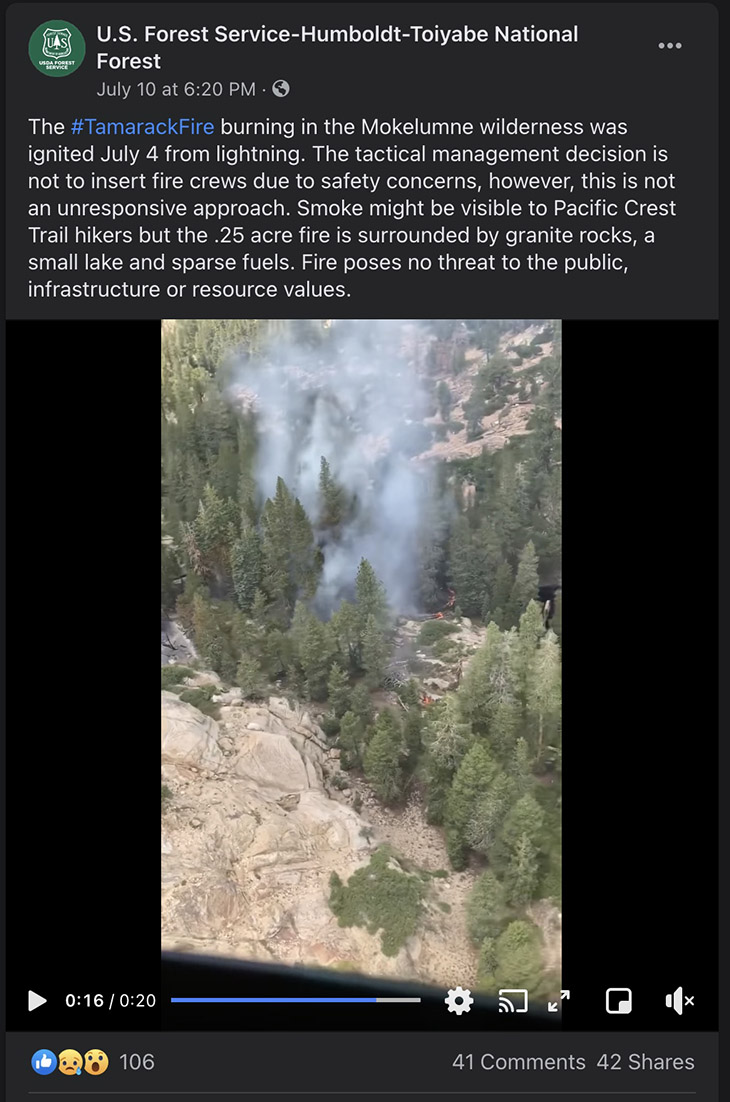2:13 p.m. PDT July 26, 2021

Firefighters on the Dixie Fire south of Chester, California had a better opportunity than they have seen recently to make progress on the blaze that has burned 197,000 acres. Dense smoke and occasional clouds shaded the area Sunday which put a damper on fire activity. The decreased intensity allowed crews to move closer to the fire’s edge to construct dozer and hand lines in some key areas including near Taylorsville, Crescent Mills, Quincy, Bucks Lake, and Greenville.
Similar weather conditions are expected Monday, but if the smoke clears there will be a significant increase in fire behavior. The forecast includes 20-30% chance of thunderstorms Monday night and Tuesday, which will be followed by increased winds and higher temperatures later this week.
To see all articles on Wildfire Today about the Dixie Fire, including the most recent, click HERE.
Engines are deployed in Taylorsville, prepping for structure protection in the event the fire reaches the area as it continues moving northeast. Sunday night firefighters began strategic firing operations using the Mount Hough Road to strengthen the fireline north of Quincy.
Poor visibility created by the smoke limited assistance fire personnel could receive from air tankers and helicopters but drones are being to gather intelligence, monitor fire activity at night, watch for spot fires, and assist in igniting tactical burning operations.
With the inability to drop fire retardant from air tankers, on Sunday water tenders filled with the slurry pretreated areas along Humbolt Road and other locations where burning operations took place. The retardant was sprayed on the opposite side of roads from where the ignitions were occurring. Firefighters always have to be cognizant of burning embers being blown across a road in a firing operation, but the report Monday morning was that no spot fires occurred Sunday night on the project where the retardant was used. Most of the tactical firing is occurring at night when weather and fuel conditions are more moderate than in the daylight hours. Air tankers can’t be used at night to drop retardant but water tenders can be operated 24 hours a day.
The fire is extremely large, reaching “megafire” status a number of days ago when it exceeded 100,000 acres. Now it is almost twice as big, with three base camps, and has an outer perimeter of 82 miles all of which has to be secured by firefighters.
Below — fighting the Dixie Fire from a train, and keeping the tracks open.
Sometimes you gotta fight wildfires from a moving train. In this footage, firefighters are using a water cannon to soak the tracks and surrounding areas as protection from the Dixie Fire, which has burned more than 100,000 acres as of July 22. pic.twitter.com/KmJNBuAT8I
— NowThis (@nowthisnews) July 26, 2021
1:25 p.m. PDT July 25, 2021

Saturday night the Dixie Fire south of Lake Almanor in Northern California merged with the Fly Fire near Highway 89 and the communities of Indian Wells and Paxton. At that time the Fly Fire was approximately 8,000 acres. With the additional growth over the last 24 hours it brings the combined size up to 190,625 acres.
The fire grew significantly Saturday in conditions that were very challenging for firefighters. The Fly Fire spread to the top of Mt. Hough and Crystal Lake and is now expected to back down the mountain to the northeast.
Saturday the east side of the fire burned into the Greenville Wye and across Highways 70 and 89. Firefighters engaged immediately in structure protection in nearby communities, with Paxton and Indian Falls being the most severely impacted. Several strike teams of engines were in the area fighting to protect structures as the fire intensified.
Extreme fire behavior is expected again Sunday, with unstable atmospheric conditions predicted that could lead to the development of large pyrocumulonimbus clouds, increasing the potential for spot fires and rapid fire growth.
This very large fire is being suppressed by two Incident Management Teams, with their areas of responsibility separated by the Highway 70 corridor.
Due to a massive smoke plume the street lights came on Saturday at 4:51 p.m. in Greenville, California, which at the time was about three miles northeast of the fire.

The burning operation underway south of Lake Almanor is going well. Crews started from Canyondam working west and are circling around the north and northwest sides of the fire working toward Butte Meadows. As of early Sunday morning crews had progressed approximately 12 miles from Canyondam, burning the fuels along a road system to create a barrier to the main fire to protect the Lake Almanor area. The objective is to tie in the burning operation with crews constructing direct fire line on the southwest side of the fire.
The prescription for the firing calls for it to be done at night, conditions that make it easier for firefighters to control the fire intensity. The ignition and prescription are similar to conducting a prescribed fire. The project can be seen on the map above, appearing as a strip of white lines south of Highway 89, with red dots signifying heat from their burning operation.





















